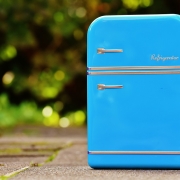Is Your Refrigerator Using Too Much Electricity?
Refrigerators have become essential in our day-to-day lives; however, not all of them are the same. In today’s world of high energy usage and high prices, you’ll certainly want a model in your home that provides you with the most use for the least amount of power. There are things you can do yourself to increase your unit’s energy-efficiency so that you can make sure that it doesn’t use too much electricity; however, if you ever need assistance with your refrigerator, you can always contact us! In the meantime, here are some things to keep in mind:
Keep Your Fridge Well-Stocked
The more your fridge has to run, and the greater the air displacement is, the more power it will use and the harder it’s going to have to work in order to cool your groceries down. When a refrigerator is empty, that air displacement is going to be high. Do be aware though, and be careful not to jam pack your fridge – having far too many items within it will limit the air movement too much, damaging energy efficiency.
Keep the Door Closed
More and more power is used every time someone opens the refrigerator door, because warmer air from the outside replaces some of the cooler air on the inside. It takes extra power and extra work for the fridge to bring the temperature level back down. Try to make a habit of opening the door only when necessary; take all ingredients out all at once rather than separately.
Watch the Temperature Setting
There is a small dial in refrigerators that control exactly how cold the temperature is set at; if you have it set too high, you’ll end up with a bunch of spoiled food. If you set your unit too cold, your food will be semi-frozen and you’ll waste money because your fridge will run too often. The recommended temperature for refrigerators according to Samsung is 37.4 degrees.
Maintenance is Crucial
It might be easy to just plug in your refrigerator and largely forget about it, letting it run until it dies years later. However, if you keep your eyes on a couple of things, you’ll find that it won’t use too much electricity and won’t die prematurely. Once every six months, unplug your unit so you can safely brush the condenser coils; if too much dust accumulates on the coils, it can cause your appliance to overheat, causing damage.
It’s important that you keep watch over your refrigerator in order to ensure that it never uses more electricity than it should. When your unit uses the least amount of energy possible, it will also cost you less money on your energy bills and will provide you with many years of good, energy-efficient service. For more information on energy efficiency and your refrigerator, or if you are ever in need of quality appliance repair, contact our experienced professionals at Absolute Appliances Repair.


